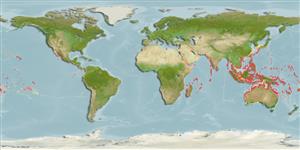Common names from other countries
Environment: milieu / climate zone / depth range / distribution range
экология
; пределы глубины 2 - 30 m (Ref. 349). Tropical
Indo-Pacific.
Length at first maturity / Size / Вес / Возраст
Maturity: Lm ? range ? - ? cm Max length : 36.0 cm ShH самец/пол неопределен; (Ref. 349); common length : 22.0 cm SHL самец/пол неопределен; (Ref. 349)
Frequently collected in the area for food and for the shell which is traditionally used as a decorative item in many parts, or as container for liquids by the natives of the South Seas (Ref. 349). Live in colonies. During periods of activity, lift their shell straight up to move forward, then drop it down. Often partially buried below the surface of sand when inactive or during feeding. Preys on the crown-of-thorns Acanthaster planci, which is recently responsible for the devastation of many coral reefs (Ref. 349).
Life cycle and mating behavior
половая зрелость | размножение | нерест | икра | Fecundity | личинки
Members of the order Neotaenioglossa are mostly gonochoric and broadcast spawners. Life cycle: Embryos develop into planktonic trocophore larvae and later into juvenile veligers before becoming fully grown adults.
Основная ссылка
ссылки | координатор | соавторы
Poutiers, J.M. 1998. (Ref. 349)
Статус Красного Списка МСОП (Ref. 130435)
Статус СИТЕС (Ref. 108899)
Not Evaluated
Not Evaluated
Использование человеком
рыболовство: коммерческий
| FishSource | Sea Around Us
инструменты
дополнительная информация
ресурсы в Интернет
Estimates based on models
Preferred temperature
(Ref.
115969): 24.6 - 29.3, mean 28.4 (based on 3285 cells).
Уязвимость
Low to moderate vulnerability (26 of 100).
Категория цены
Unknown.
